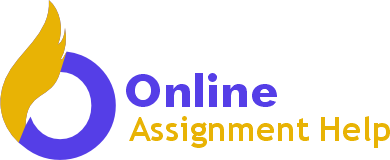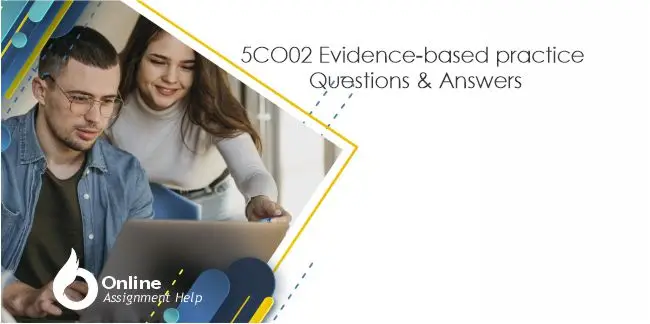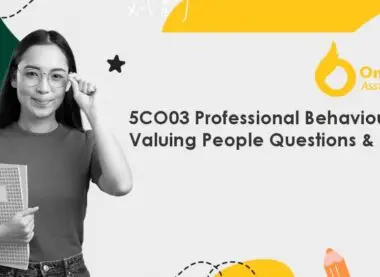Table of Contents
5CO02 Evidence-based practice Questions
Briefing Paper – Part one
- evaluate the concept of evidence-based practice including how approaches to evidence-based practice can be used to provide insight that supports sound decision-making across a range of people practices and organisational issues. (AC 1.1)
- evaluate one appropriate analysis tool and one appropriate analysis method that might be applied by organisations to recognise and diagnose issues, challenges, and opportunities. (AC 1.2)
- explain the main principles of critical thinking including how these might apply to your own and others’ ideas to assist objective and rational debate. (AC 1.3)
- explain two decision-making processes for achieving effective outcomes. (AC 1.4)
- assess how two different ethical perspectives can be used to inform and influence moral decision-making. (AC 1.5)
- appraise two different ways organisations measure financial and non-financial performance, providing one example of each. (AC 3.1)
- explain how people practices add value in an organisation and identify two methods that might be used to measure the impact of people practices. (AC 3.2)
For part one, you need to provide the graduates with knowledge and understanding of what evidence-based practice is and identify approaches that can be taken for effective critical thinking and decision-making that ensures integrity and value is upheld.
You must ensure that you:
- evaluate the concept of evidence-based practice including how approaches to evidence-based practice can be used to provide insight that supports sound decision-making across a range of people practices and organisational issues. (AC 1.1)
- evaluate one appropriate analysis tool and one appropriate analysis method that might be applied by organisations to recognise and diagnose issues, challenges, and opportunities. (AC 1.2)
- explain the main principles of critical thinking including how these might apply to your own and others’ ideas to assist objective and rational debate. (AC 1.3)
- explain two decision-making processes for achieving effective outcomes. (AC 1.4)
- assess how two different ethical perspectives can be used to inform and influence moral decision-making. (AC 1.5)
- appraise two different ways organisations measure financial and non-financial performance, providing one example of each. (AC 3.1)
- explain how people practices add value in an organisation and identify two methods that might be used to measure the impact of people practices. (AC 3.2)
In part two of your briefing paper, using the information in Table 1 and Table 2 below, you should provide examples of the types of data analysis that people practitioners use. (AC 2.1,
AC 2.2 and AC 2.3)
Table 1 – Performance data – (please double click on the icon to open the table)
Table one provides performance review judgements for employees from four departments completed across two quarters. Each individual employee’s performance outcome is indicated by one of the four criteria-based judgements below:
- outstanding
- meets set individual Key Performance Indicators
- not quite there yet, and
- underperforming.
- Present each department’s performance review judgements as a percentage.
- Those gaining ‘outstanding’ are entitled to a four percent bonus payment each quarter. Calculate the bonus due to each of these employees for each quarter and then provide an overall total cost of bonus payments for the organisation.
Present your findings from Table 1 using a minimum of three appropriate diagrammatical forms and make justifiable recommendations based on your evaluations.
The survey data presented in Table 2 has been collected from managers and employees on their views of the organisation’s approach to monitoring performance. Review the data in Table 2 and identify any patterns, themes or trends that might be occurring and present recommendations based on your findings.
Table 2 – Performance review survey responses from line managers and employees
There is no requirement to include evidence of the use of references to wider reading for
AC 2.1 and AC 2.2.
5CO02 Assignment Answers
(AC 1.1 ) Evaluate the concept of evidence-based practice including how it can be applied to decision-making in people practice.
Definition
Evidence-based practice (EBP) is a systematic approach to decision-making that prioritizes the use of the best available research evidence (Howard, Diug & Ilic, 2022). It involves a rigorous process of identifying, appraising, and applying high-quality research to inform clinical practice. This approach goes beyond traditional methods, which often rely on personal experience or anecdotal evidence. By integrating scientific research with clinical expertise and patient values, EBP aims to improve the quality of care and patient outcomes. This ensures that decisions are informed, evidence-based, and ultimately beneficial for patients.
EBP evaluation
Evidence-based practice (EBP) has revolutionized the way healthcare professionals make decisions, promoting a more scientific and patient-centered approach. By emphasizing the use of high-quality research evidence, EBP ensures that interventions and treatments are effective and safe (Engle et al,2021). It empowers practitioners to make informed choices, reducing reliance on outdated practices or personal opinions. Moreover, EBP fosters a culture of continuous learning and improvement, encouraging healthcare professionals to stay updated with the latest research findings.
However, EBP is not without its limitations. One significant challenge is the time and effort required to locate, critically appraise, and apply relevant research evidence. Additionally, the quality and quantity of available research may vary across different areas of practice. Moreover, EBP can be hindered by factors such as organizational barriers, lack of resources, and resistance to change. Furthermore, while EBP emphasizes evidence-based decision-making, it also acknowledges the importance of clinical expertise and patient values. Striking the right balance between these three components can be complex, especially in situations with limited evidence or conflicting recommendations.
EBP application
Two common people practice issues that can benefit from evidence-based practice (EBP) are employee engagement and diversity, equity, and inclusion (DEI) (Byrne,, 2022; West et al, 2018).
A highly engaged workforce is crucial for organizational success. EBP can help organizations identify effective strategies to boost employee engagement. By reviewing research on factors such as leadership style, recognition programs, and work-life balance, organizations can implement evidence-based interventions. For instance, if research suggests that regular feedback and coaching improve employee engagement, organizations can provide managers with training on effective feedback techniques.
Secondly, Creating a diverse, equitable, and inclusive workplace is essential for attracting and retaining top talent. EBP can guide organizations in developing and implementing effective DEI initiatives. By examining research on unconscious bias, inclusive leadership, and diversity training, organizations can make informed decisions about their DEI strategies. For example, if research indicates that unconscious bias training can reduce workplace discrimination, organizations can invest in such training for their employees.
By applying EBP to these people practice issues, organizations can make data-driven decisions that are more likely to lead to positive outcomes.
(AC1.2) Evaluate a range of analysis tools and methods including how they can be applied to diagnose organisational issues, challenges and opportunities.
SWOT
SWOT analysis, a simple yet powerful tool, is widely used to recognize and diagnose organizational issues, challenges, and opportunities. By categorizing factors into four key areas – Strengths, Weaknesses, Opportunities, and Threats – it provides a structured framework for understanding an organization’s internal and external environment (Sammut‐Bonnici & Galea, 2015).
One common application is in strategic HR planning. By conducting a SWOT analysis, HR can assess the organization’s current talent pool, identify skill gaps, and develop strategies to attract, retain, and develop top talent. Another application of SWOT analysis in people practice is in performance management.7 By analyzing an employee’s strengths, weaknesses, opportunities, and threats, HR can identify areas for improvement and development.8 This information can be used to set performance goals, provide feedback, and create personalized development plans.9 Additionally, SWOT analysis can be useful in identifying potential performance issues and developing strategies to address them.10
Strengths / weaknesses
SWOT analysis is a versatile tool that offers several advantages. Its simplicity makes it accessible to a wide range of individuals and organizations. By categorizing factors into four distinct areas, SWOT provides a clear and concise overview of an organization’s internal and external environment. This holistic perspective enables a comprehensive understanding of the organization’s strengths, weaknesses, opportunities, and threats.
Furthermore, SWOT analysis encourages strategic thinking and decision-making. By identifying strengths and weaknesses, organizations can capitalize on their competitive advantages and address internal limitations. Similarly, by recognizing opportunities and threats, organizations can develop strategies to seize market opportunities and mitigate potential risks.
Despite its advantages, SWOT analysis has certain limitations. One significant drawback is its subjective nature. The identification of strengths, weaknesses, opportunities, and threats often relies on individual perceptions and biases, which can lead to inaccurate assessments. Additionally, SWOT analysis may oversimplify complex organizational issues, failing to capture the nuances of the business environment.
Another limitation is its lack of prioritization. While SWOT identifies potential areas for strategic action, it doesn’t provide a clear framework for prioritizing these areas. This can lead to a lack of focus and resource allocation. Moreover, SWOT analysis is a static tool that doesn’t account for dynamic changes in the business environment. As market conditions and competitive landscapes evolve, the relevance of a SWOT analysis may diminish over time.
To mitigate these weaknesses, it is advisable to combine SWOT analysis with other tools and techniques, such as PESTLE analysis or Porter’s Five Forces, to gain a more comprehensive understanding of the organization’s strategic landscape. Additionally, involving a diverse group of stakeholders in the SWOT analysis process can help mitigate bias and ensure a more balanced perspective.
(AC1.3 ) Explain the principles of critical thinking including how you apply these to your own and others’ ideas.
Main principles
Critical thinking, the ability to think clearly and rationally, is a fundamental skill that empowers individuals to analyze information, evaluate arguments, and form sound judgments. It involves a complex interplay of cognitive processes, including analysis, synthesis, evaluation, and interpretation (Paul & Elder, 2019). By understanding and applying the principles of critical thinking, individuals can enhance their problem-solving abilities, decision-making skills, and overall intellectual development.
Central to critical thinking is the pursuit of clarity and precision. This entails clearly defining problems, formulating precise questions, and avoiding ambiguity. By striving for clarity, individuals can ensure that their thinking is focused and their arguments are well-supported. Additionally, critical thinking demands a commitment to logical reasoning and evidence-based analysis. This involves identifying underlying assumptions, evaluating evidence for its relevance and reliability, and recognizing logical fallacies. By applying these principles, individuals can avoid making hasty conclusions and ensure that their reasoning is sound.
Application
In my own life, I’ve applied critical thinking to numerous situations. For instance, when considering a career path, I carefully analyzed my interests, skills, and values, and evaluated the potential opportunities and challenges associated with different professions. By critically examining the available information and considering the long-term implications of my choices, I was able to make an informed decision that aligned with my goals.
When considering others’ ideas, I strive to maintain an open mind and approach each viewpoint with curiosity. I actively listen to others’ perspectives, seeking to understand their underlying assumptions and reasoning. By questioning the evidence and logic behind their arguments, I can identify potential flaws and inconsistencies. For example, during a recent class discussion on climate change, I challenged a classmate’s claim that global warming is a hoax. By presenting counterarguments based on scientific evidence and highlighting the logical fallacies in their reasoning, I was able to stimulate a more productive and informed debate.
In debate
Critical thinking plays a vital role in fostering rational and objective debate. By encouraging individuals to question assumptions, evaluate evidence, and consider alternative perspectives, it promotes a culture of intellectual inquiry. When participants in a debate engage in critical thinking, they are more likely to avoid emotional appeals and focus on the substance of the arguments. This leads to more productive discussions, where ideas are challenged and refined through rigorous analysis.
In summary, critical thinking is an essential skill that empowers individuals to think critically, solve problems effectively, and make informed decisions. By applying the principles of clarity, precision, logical reasoning, and evidence-based analysis, individuals can enhance their intellectual capabilities and contribute to meaningful discussions.13 Whether it’s evaluating personal choices or engaging in public discourse, critical thinking is a valuable tool that can help us navigate the complexities of the modern world.
(AC1.4) Explain a range of (2) decision-making processes.
Two processes
Decision-making is a fundamental aspect of people practice, influencing various aspects of an organization, from recruitment and selection to performance management and employee relations. Effective decision-making is crucial for achieving organizational goals and ensuring employee satisfaction. People professionals employ a range of decision-making processes to navigate complex challenges and make informed choices.
One common decision-making process used by people professionals is the rational decision-making model. This model involves a systematic approach to decision-making, consisting of several steps (Uzonwanne, 2023). First is, problem identification: Clearly defining the problem or issue at hand. Second is information gathering: Collecting relevant data and information to understand the problem. Third is, alternative generation: Identifying various potential solutions or courses of action. Fourth is evaluation of alternatives: Assessing the pros and cons of each alternative, considering factors such as feasibility, cost-effectiveness, and potential impact. Fifth is decision making: Selecting the best alternative based on the evaluation. Sixth is implementation: Putting the chosen alternative into action. Seventh is evaluation: Assessing the outcomes of the decision and making adjustments as needed.
Another decision-making process used by people professionals is intuitive decision-making. This approach relies on gut feelings, intuition, and past experiences to make decisions (Klein, 2015). While it may seem less structured than the rational decision-making model, intuitive decision-making can be highly effective, especially in situations where time is limited or information is scarce. People professionals can enhance the effectiveness of intuitive decision-making by developing their intuition through experience and self-awareness. They can also combine intuitive decision-making with rational analysis to make more informed choices.
Efficacy
To ensure effective outcomes, people professionals can use several strategies when applying the rational decision-making model. First, they should strive to gather as much relevant information as possible to inform their decision-making. This may involve conducting surveys, interviews, or analyzing data. Second, they should involve key stakeholders in the decision-making process to gain diverse perspectives and ensure buy-in. Third, they should consider the long-term implications of their decisions, not just the immediate benefits. Finally, they should be prepared to adapt their decisions as circumstances change.
To ensure effective outcomes when using intuitive decision-making, people professionals can employ several strategies. First, they should trust their instincts, but also be mindful of potential biases. Second, they should seek feedback from others to validate their intuition. Third, they should be open to changing their minds if new information emerges.
In conclusion, people professionals utilize a variety of decision-making processes to address the complex challenges they face. By understanding the strengths and limitations of different approaches, such as the rational decision-making model and intuitive decision-making, people professionals can make informed choices that positively impact their organizations.
(AC1.5) Assess how (2) different ethical perspectives can influence decision-making.
Utilitarianism is a consequentialist ethical theory that prioritizes the greatest good for the greatest number of people (Marques, 2015). When faced with a decision, a utilitarian would consider the potential consequences of each action and choose the one that maximizes overall happiness or minimizes suffering. This approach can be applied in people practice by evaluating the impact of HR decisions on the organization and its employees. For example, when deciding on a new performance management system, a utilitarian HR professional would weigh the potential benefits, such as improved employee performance and organizational productivity, against the potential costs, such as increased workload and employee dissatisfaction. While utilitarianism can be a useful tool for making decisions that benefit the majority, it may sometimes lead to decisions that harm a minority group.
Utilitarianism, while aiming for the greatest good for the greatest number, has several weaknesses. It can be challenging to accurately predict the long-term consequences of actions, making it difficult to determine the most beneficial course. Additionally, it can justify actions that may seem morally wrong if they lead to a greater overall good, potentially disregarding individual rights and justice. Moreover, it can be difficult to quantify and compare different types of happiness or suffering, making it challenging to make objective decisions.
Universalism, also known as deontological ethics, emphasizes the importance of moral rules and principles (Marques, 2015). It suggests that certain actions are inherently right or wrong, regardless of their consequences. In people practice, a universalist approach would prioritize fairness, justice, and respect for individual rights. For example, when making decisions about hiring or promotion, a universalist HR professional would ensure that all candidates are treated fairly and that the selection process is free from bias. While universalism provides a strong ethical foundation, it can sometimes be rigid and inflexible, leading to difficulties in resolving complex ethical dilemmas.
Universalism, while emphasizing fairness and justice, can be overly rigid and inflexible. It may not adequately account for the complexities of real-world situations, where rigid adherence to rules can sometimes lead to unintended negative consequences. Additionally, it can be challenging to determine which moral principles are universally valid and how to prioritize them when they conflict. Moreover, universalism may not sufficiently consider the individual circumstances and needs of people, potentially leading to a one-size-fits-all approach that is not always appropriate.
By understanding these two ethical theories, people professionals can make more informed and ethical decisions. Utilitarianism encourages them to consider the broader impact of their actions, while universalism emphasizes the importance of fairness and justice. By combining these perspectives, HR professionals can develop a more nuanced and comprehensive approach to ethical decision-making.
(AC3.1) Appraise (2) different ways organisations measure financial and non-financial performance.
Organizations, in their quest for sustained success and growth, often rely on a blend of financial and non-financial performance metrics. These metrics serve as vital tools for measuring an organization’s overall health, identifying areas for improvement, and making informed strategic decisions.
Financial performance metric
One crucial financial performance metric is Return on Investment (ROI). ROI measures the profitability of an investment relative to its cost (Bichard, 2015). It’s calculated by dividing the net profit from an investment by the cost of the investment. A higher ROI indicates a more profitable investment. While ROI is a simple and understandable metric, it has its limitations. For instance, it may not accurately reflect the long-term value of an investment, as it doesn’t account for the time value of money. Additionally, comparing ROI across projects with different time horizons can be challenging. A people professional might use ROI to evaluate the financial impact of HR initiatives, such as training programs or recruitment campaigns. By measuring the return on investment of these initiatives, HR professionals can justify the allocation of resources and demonstrate their value to the organization.
Non-financial metrics
While financial metrics provide a quantitative snapshot of an organization’s performance, non-financial metrics offer a broader perspective. One such metric is Employee Net Promoter Score (eNPS). eNPS measures employee loyalty and satisfaction by asking employees to rate their likelihood of recommending the company as a workplace on a scale of 0 to 10 (Yaneva, 2018). The eNPS is calculated by subtracting the percentage of detractors (those who score 0-6) from the percentage of promoters (those who score 9-10). A higher eNPS indicates a more engaged and satisfied workforce. While eNPS is a simple and effective metric, it has its limitations. It may not provide granular insights into specific areas of employee dissatisfaction, and it can be susceptible to social desirability bias. People professionals can use eNPS to assess the impact of HR initiatives on employee satisfaction and engagement. By tracking eNPS over time, HR can identify trends and take action to improve the employee experience.
By effectively measuring both financial and non-financial performance, organizations can gain a comprehensive understanding of their overall health and make informed decisions to drive sustainable growth and success.
(AC3.2) Explain how to measure the impact and value of people practice using a variety of (2) methods.
People practice, once considered a mere administrative function, has evolved into a strategic business partner, driving organizational success. By aligning people strategies with business objectives, HR professionals can significantly contribute to an organization’s bottom line.
One of the core values that people practice brings to an organization is enhanced employee engagement (Sun & Bunchapattanasakda, 2019). Engaged employees are more productive, innovative, and committed to the organization’s goals. HR practices, such as effective performance management, recognition programs, and opportunities for professional development, can foster a positive work environment and boost employee morale. For instance, a well-structured performance management system can provide employees with clear expectations, regular feedback, and opportunities for growth, leading to increased job satisfaction and improved performance.
To measure the impact of people practices, organizations can employ a variety of methods. One such method is Return on Investment (ROI). By calculating the financial benefits of HR initiatives, organizations can assess their effectiveness (Bichard, 2015). For example, the ROI of a training program can be measured by comparing the increased productivity of trained employees to the cost of the training. While ROI is a quantitative measure, it may not capture the full impact of people practices, particularly those that contribute to long-term organizational success, such as employee retention and talent development.
Another valuable method for measuring the impact of people practices is employee surveys (Boxall, Guthrie & Paauwe, 2016). By collecting feedback from employees, organizations can gain insights into their perceptions of the work environment, leadership, and HR policies. Employee surveys can help identify areas for improvement, measure employee satisfaction, and track changes in employee morale over time. However, the effectiveness of employee surveys depends on the quality of the questions, the honesty of the responses, and the organization’s commitment to taking action on the feedback received.
In conclusion, people practice plays a critical role in driving organizational success. By focusing on employee engagement, talent development, and organizational culture, HR professionals can create a high-performing workforce and contribute to the organization’s bottom line. By employing a variety of measurement methods, such as ROI and employee surveys, organizations can assess the impact of their people practices and make data-driven decisions to improve their effectiveness.
(AC2.1) With reference to a people practice issue, interpret analytical data using appropriate analysis tools and methods.
The performance review data indicates that a substantial number of employees across various departments received performance bonuses. In the first quarter, 18% of Administration and 20% of Logistics employees excelled, earning bonuses. While Administration’s bonus recipients decreased to 9% in the second quarter, Logistics saw an increase to 25%. Additionally, Research and Development experienced a significant boost in outstanding performance, with 30% of employees receiving bonuses in the first quarter and 50% in the second.
The total cost of performance bonuses reached £21,550.00, with Research and Development incurring the highest expenditure, followed by Logistics and Administration. In terms of individual performance, a significant number of employees met their Key Performance Indicators (KPIs). Administration saw an increase from 18% to 36% of employees meeting KPIs between the first and second quarters. Logistics maintained a strong performance, with 40% and 45% of employees meeting KPIs in the respective quarters. Research and Development consistently had 30% of employees meeting KPIs.
However, the data also highlights areas for improvement. Administration had 27% underperforming employees in the first quarter, decreasing to 9% in the second. Additionally, 9% of employees were absent in the first quarter. Logistics faced similar challenges, with 10% underperforming in the first quarter and 10% absent in the second. Research and Development had 10% of employees categorized as “not quite there” in both quarters, and 10% were absent in the second quarter.
The Sales department stands out with a perfect performance, as 100% of employees met their KPIs and had no underperformance or absences.
Based on the performance review data, several recommendations can be made to improve overall performance. Firstly, recognizing and rewarding top performers, especially in Research and Development, is crucial. This can be achieved through bonuses, promotions, or public recognition. Secondly, addressing underperformance and absenteeism, particularly in Administration and Logistics, is essential. Identifying root causes and implementing targeted interventions, such as training or coaching, can help. Thirdly, improving the performance of the Logistics department through performance management systems, feedback, and clear expectations is crucial. Lastly, maintaining the Sales department’s high performance requires ongoing training, recognition, and addressing emerging challenges. A comprehensive performance management system that includes regular reviews, goal setting, feedback, and coaching can further enhance overall performance and employee engagement. This system can help to identify performance gaps, track progress, and provide employees with the support they need to succeed.
By implementing these recommendations, the company can improve overall performance, enhance employee engagement, and achieve its strategic goals.
(AC2.2) Present key findings for stakeholders from people practice activities and initiatives.
The survey results highlight several areas where the organization’s performance management practices need improvement. Many line managers feel confident conducting performance appraisals, but concerns exist about their ability to assess performance fairly. Additionally, while some managers feel confident in providing feedback and setting targets, others struggle with these aspects. The lack of training on performance appraisals further exacerbates these issues.
To address these shortcomings, the organization should prioritize training for line managers. This training should cover essential skills like setting clear expectations, delivering constructive feedback, and objectively assessing performance. Additionally, the performance management system should be refined with a standardized review form and regular feedback mechanisms. Fostering open communication through regular meetings and surveys is crucial for building strong manager-employee relationships.
From the employee perspective, the survey reveals a lack of engagement during performance reviews and inconsistencies in feedback delivery. To improve this, line managers should receive training in active listening and constructive feedback. Creating a culture of open communication through regular meetings and surveys can enhance understanding. Investing in employee development through training and coaching opportunities can boost job satisfaction and motivation. A robust performance management system with clear expectations, regular feedback, and timely reviews is essential for aligning employee goals with organizational objectives.
By implementing these recommendations, the organization can significantly enhance its performance management practices, leading to improved employee engagement, motivation, and overall performance.
(AC2.3) Make justified recommendations based on evaluation of the benefits, risks and financial implications of potential solutions.
The survey data identifies a number of areas where the organization’s performance management procedures might be strengthened.
First and foremost, good communication is essential. Training in constructive criticism, meaningful performance evaluations, and active listening should be provided to line managers. The quality of interactions between managers and staff will improve as a result. Second, it’s critical to cultivate an open culture. Frequent team meetings, one-on-one conversations, and employee surveys help foster an atmosphere where workers feel free to express their opinions. Better communication and stronger relationships will result from this.
Thirdly, the development of employees ought to be given top priority. Putting money into coaching, mentoring, and training programs can assist staff members develop professionally, which will boost their motivation and work satisfaction. Fourth, a strong system of performance management is necessary. Timely performance reviews, frequent feedback, and unambiguous expectations should all be part of this approach. Employee motivation to contribute to the organization’s overall performance may be achieved by coordinating the system with its strategic goals.
The company may greatly enhance employee motivation, engagement, and performance by putting these suggestions into practice.
References
Please provide your full long reference list here. The Harvard method is preferable. Please refer to the guidance on the Learner HUB.
Bichard, E. (2015). Developing an approach to sustainable return on investment.
Boxall, P., Guthrie, J. P., & Paauwe, J. (2016). Editorial introduction: Progressing our understanding of the mediating variables linking HRM, employee well-being and organisational performance. Human Resource Management Journal, 26(2).
Byrne, Z. S. (2022). Understanding employee engagement: Theory, research, and practice. Routledge.
Engle, R. L., Mohr, D. C., Holmes, S. K., Seibert, M. N., Afable, M., Leyson, J., & Meterko, M. (2021). Evidence-based practice and patient-centered care: doing both well. Health care management review, 46(3), 174-184.
Howard, B., Diug, B., & Ilic, D. (2022). Methods of teaching evidence-based practice: a systematic review. BMC Medical Education, 22(1), 742.
Klein, G. (2015). A naturalistic decision making perspective on studying intuitive decision making. Journal of applied research in memory and cognition, 4(3), 164-168.
Marques, J. (2015). Universalism and utilitarianism: An evaluation of two popular moral theories in business decision making. The Journal of Values-Based Leadership, 8(2), 3.
Paul, R., & Elder, L. (2019). The miniature guide to critical thinking concepts and tools. Rowman & Littlefield.
Sammut‐Bonnici, T., & Galea, D. (2015). SWOT analysis. Wiley Encyclopedia of management, 1-8.
Sun, L., & Bunchapattanasakda, C. (2019). Employee engagement: A literature review. International Journal of Human Resource Studies, 9(1), 63-80.
Uzonwanne, F. C. (2023). Rational model of decision-making. In Global encyclopedia of public administration, public policy, and governance (pp. 11230-11235). Cham: Springer International Publishing.
West, M. A., Hwang, S., Maier, R. V., Ahuja, N., Angelos, P., Bass, B. L., … & Wren, S. M. (2018). Ensuring equity, diversity, and inclusion in academic surgery: an American Surgical Association white paper. Annals of surgery, 268(3), 403-407.
Yaneva, M. (2018). Employee satisfaction vs. employee engagement vs. employee NPS. European Journal of Economics and Business Studies, 4(1), 221-227.









